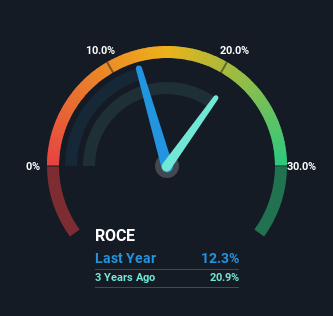We Like These Underlying Return On Capital Trends At Speedvalue (TLV:SPDV)
If you're not sure where to start when looking for the next multi-bagger, there are a few key trends you should keep an eye out for. Firstly, we'll want to see a proven return on capital employed (ROCE) that is increasing, and secondly, an expanding base of capital employed. Put simply, these types of businesses are compounding machines, meaning they are continually reinvesting their earnings at ever-higher rates of return. Speaking of which, we noticed some great changes in Speedvalue's (TLV:SPDV) returns on capital, so let's have a look.
Understanding Return On Capital Employed (ROCE)
For those who don't know, ROCE is a measure of a company's yearly pre-tax profit (its return), relative to the capital employed in the business. Analysts use this formula to calculate it for Speedvalue:
Return on Capital Employed = Earnings Before Interest and Tax (EBIT) ÷ (Total Assets - Current Liabilities)
0.12 = ₪6.4m ÷ (₪69m - ₪17m) (Based on the trailing twelve months to December 2023).
Thus, Speedvalue has an ROCE of 12%. In isolation, that's a pretty standard return but against the IT industry average of 19%, it's not as good.
Check out our latest analysis for Speedvalue

While the past is not representative of the future, it can be helpful to know how a company has performed historically, which is why we have this chart above. If you're interested in investigating Speedvalue's past further, check out this free graph covering Speedvalue's past earnings, revenue and cash flow.
What The Trend Of ROCE Can Tell Us
We like the trends that we're seeing from Speedvalue. The data shows that returns on capital have increased substantially over the last four years to 12%. The amount of capital employed has increased too, by 104%. So we're very much inspired by what we're seeing at Speedvalue thanks to its ability to profitably reinvest capital.
One more thing to note, Speedvalue has decreased current liabilities to 25% of total assets over this period, which effectively reduces the amount of funding from suppliers or short-term creditors. This tells us that Speedvalue has grown its returns without a reliance on increasing their current liabilities, which we're very happy with.
The Bottom Line On Speedvalue's ROCE
In summary, it's great to see that Speedvalue can compound returns by consistently reinvesting capital at increasing rates of return, because these are some of the key ingredients of those highly sought after multi-baggers. Astute investors may have an opportunity here because the stock has declined 70% in the last three years. So researching this company further and determining whether or not these trends will continue seems justified.
On a final note, we've found 2 warning signs for Speedvalue that we think you should be aware of.
If you want to search for solid companies with great earnings, check out this free list of companies with good balance sheets and impressive returns on equity.
New: Manage All Your Stock Portfolios in One Place
We've created the ultimate portfolio companion for stock investors, and it's free.
• Connect an unlimited number of Portfolios and see your total in one currency
• Be alerted to new Warning Signs or Risks via email or mobile
• Track the Fair Value of your stocks
Have feedback on this article? Concerned about the content? Get in touch with us directly. Alternatively, email editorial-team (at) simplywallst.com.
This article by Simply Wall St is general in nature. We provide commentary based on historical data and analyst forecasts only using an unbiased methodology and our articles are not intended to be financial advice. It does not constitute a recommendation to buy or sell any stock, and does not take account of your objectives, or your financial situation. We aim to bring you long-term focused analysis driven by fundamental data. Note that our analysis may not factor in the latest price-sensitive company announcements or qualitative material. Simply Wall St has no position in any stocks mentioned.
About TASE:SPDV
Excellent balance sheet with low risk.
Similar Companies
Market Insights
Weekly Picks


Crazy Undervalued 42 Baggers Silver Play (Active & Running Mine)


Fiducian: Compliance Clouds or Value Opportunity?

Willamette Valley Vineyards (WVVI): Not-So-Great Value
Recently Updated Narratives

THE KINGDOM OF BROWN GOODS: WHY MGPI IS BEING CRUSHED BY INVENTORY & PRIMED FOR RESURRECTION


The "Molecular Pencil": Why Beam's Technology is Built to Win


ADNOC Gas future shines with a 21.4% revenue surge
Popular Narratives


MicroVision will explode future revenue by 380.37% with a vision towards success


NVDA: Expanding AI Demand Will Drive Major Data Center Investments Through 2026




